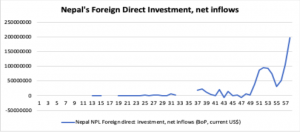Over the past few years Nepal has undergone a comprehensive political transition. The Jan Andolan (People’s Movement), which rose to power in 2006, has overseen major changes to the political landscape; from writing a new Constitution to establishing a federal system of government. Most importantly, the Government of Nepal (GoN) has outlined a series of revolutionary economic development goals. It has targeted 8% growth in the 2018/19 budget and according to the Central Bureau of Statistics (CBS), the economy achieved a 6.81% growth rate in 2018/19. Since 2000, the country has witnessed a growth rate of over 6% for three years in a row.
Nepal is trying to send a strong message to foreign investors that it is no longer hesitant to open its economy. In this regard, Foreign Direct Investment (FDI) is undoubtedly the most promising area of potential growth in the process of development.
As a result of this, the Prime Minister of Nepal KP Oli addressed the session name “Strategic Outlook on South Asia” at the 49th Annual Meeting of World Economic Forum (WEF) held in Davos, Switzerland. He stated that Nepal is set to welcome foreign investment from across the globe. After the WEF, Nepal revamped its policies to attract foreign investment and hosted the Nepal Investment Summit in 2019. Policy reform initiatives are the beacon of hope for foreign investment in Nepal.
Nepal’s FDI Policy
The Government of Nepal introduced three key pieces of legislation to attract increased foreign direct investment (FDI), namely with the Foreign Investment and Technology Transfer Act, Public-Private Partnership and Investment Act, and Special Economic Zone Act (First Amendment),aiming for increased technological, skills and knowledge based investment in the priority sectors of the Nepal’s economy. Flaws of previous FDI related legislation have been corrected in the new comprehensive reforms. The key agencies responsible for administering and implementing the rules and regulations of FDI are the Department of Industries, Investment Board of Nepal (IBN) and Nepal Rastra Bank (NRB) respectively.
To facilitate the smooth investment process, the government will be implementing a one-stop service system, where those industries with capital above NPR 100 million (USD 900 thousand) and foreign direct investments up to the limit of NPR six billion (USD 54 million) will avail the services of investment approval, labor permit, visa facility, environmental impact assessment and approval of foreign exchange. The Investment Board of Nepal will take care of investment above NPR six billion (USD 54 million). This is a major breakthrough when it comes to ease of doing business in Nepal.
FDI Trend
FDI inflows were 0.79% of GDP or US$198 million in 2017, up 87% from US$106 million (in 2016). Hence, FDI inflows are below 1% of GDP.
Nepal can learn a lesson from countries such as Cambodia and Laos when it comes to attracting FDI. FDI inflows in Cambodia and Laos are 12.55 and 4.86% of GDP respectively. For these Southeast Asian countries, FDI has been truly transformative. They have successfully turned their economies into regional exporting platforms through strengthening domestic enterprise capabilities and market access. At present, FDI inflows have been mainly centered in energy sectors. It is high time Nepal shall diversify the FDI into other productive sectors such as tourism, Information and Communication Technology (ICT) and agri-business.
Source: World Development Indicators
Leverage FDI
FDI is effective and beneficial if it leads to productive growth. It achieves this through specialisation of production,in turn increasing competition within the market. FDI comprises an inflow of resources such as technology, capital and enterprise, developing the recipient. Nepal has abundant opportunities to leverage FDI in sustainable infrastructure development, such as in hydropower, transportation, manufacturing and tourism.
The only downside of FDI is that it outclasses domestic players if they can’t perform on par with foreign players. The cut-throat competition enables the consumer to buy quality products and avail best services in the market.
Why Invest in Nepal?
Nepal is the emerging destination for FDI in South Asia. Nepal’s economically active population is above 50%. Availability of cheap labour and the existence of a business friendly environment creates a favorable investment climate in the country. Demographic structure, geographic location and reformed policies related to FDI could attract a significant number of foreign investors to Nepal.
Realising the potential benefits of market liberalization, the Nepalese government has made a series of efforts to welcome foreign investment. Situated between two giant economies, Nepal can act as a transit point for Indo-Sino trade to improve its balance of payment. FDI could be the game changer for Nepal if it can improve the competitiveness of the private sector and integrate fully into global markets.
This piece solely expresses the opinion of the author and not necessarily the organisation as a whole. Students For Liberty is committed to facilitating a broad dialogue for liberty, representing a variety of opinions. If you’re a student interested in presenting your perspective on this blog, click here to submit a guest post!
Image: Pixabay

